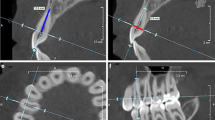Abstract
Objectives
Knowledge of the position and configuration of the mandibular canal is a basic requirement before implant placement in the mandible. Radiological studies suggest a positive correlation between alveolar trabecular bone quality and mandibular canal corticalization. The aim of this study was to test this assumption histomorphometrically in the anterior molar region, which is one of the most frequent places for implantation.
Materials and methods
Fifty thin ground sections (from 28 male and 22 female cadavers) of the first molar region were investigated for trabecular bone volume and thickness and the presence of a mandibular canal wall.
Results
Trabecular bone volume was significantly higher in males (p = 0.009). Further, it correlated significantly with the presence of a canal wall (rho = 0.585, p < 0.001), indicating that a reduced trabecular bone volume is associated with a reduced amount of bone surrounding the alveolar nerve. The cranial aspects of the canal wall were present at a significantly lower frequency (64.64 %) than the buccal, lingual, or caudal sides (p < 0.006).
Conclusion
The present study demonstrated that low trabecular bone volume correlates with only a fragmentarily present mandibular canal wall. This suggests that bone surrounding the alveolar nerve is of trabecular, not cortical, origin and possibly affected by reduction of the trabecular bone.
Clinical relevance
These results imply that oral surgeons should pay particular attention to implant placement in patients with low alveolar bone quality. The cranial aspects of the mandibular canal might be only fragmentarily or even completely missing. Consequently, they hardly present resistance during implant site preparation, and the risk for nerve injury, e.g., due to post-surgery hematoma, could be increased.




Similar content being viewed by others
References
Fawcett E (1895) The structure of the inferior maxilla, with special reference to the position of the inferior dental canal. J Anat Physiol 29:355–366
Sammartino G, Marenzi G, Citarella R et al (2008) Analysis of the occlusal stress transmitted to the inferior alveolar nerve by an osseointegrated threaded fixture. J Periodontol 79:1735–1744
Worthington P (2004) Injury to the inferior alveolar nerve during implant placement: a formula for protection of the patient and clinician. Int J Oral Maxillofac Implants 19:731–734
Basa O, Dilek OC (2011) Assessment of the risk of perforation of the mandibular canal by implant drill using density and thickness parameters. Gerodontology 28:213–220
Misch CE (1990) Density of bone: effect on treatment plans, surgical approach, healing, and progressive bone loading. Int J Oral Implantol 6:23–31
Naitoh M, Katsumata A, Kubota Y et al (2009) Relationship between cancellous bone density and mandibular canal depiction. Implant Dent 18:112–118
de Oliveira-Santos C, Souza PH, de Azambuja B-CS et al (2012) Assessment of variations of the mandibular canal through cone beam computed tomography. Clin Oral Investig 16:387–393
Polland KE, Munro S, Reford G et al (2001) The mandibular canal of the edentulous jaw. Clin Anat 14:445–452
Woelfel JB, Scheid RC (1997) Dental anatomy: its relevance to dentistry. Lippincott Williams and Wilkins, Philadelphia
Donath K (1988) Die Trenn-Dünnschliff-Technik zur Herstellung histologischer Präparate von nicht schneidbaren Geweben und Materialien. Der Präparator 34:197–206
Parfitt AM, Mathews CH, Villanueva AR et al (1983) Relationships between surface, volume, and thickness of iliac trabecular bone in aging and in osteoporosis. Implications for the microanatomic and cellular mechanisms of bone loss. J Clin Invest 72:1396–1409
Ulm C, Tepper G, Blahout R et al (2009) Characteristic features of trabecular bone in edentulous mandibles. Clin Oral Implants Res 20:594–600
Ring A (1968) Röntgenologisch-anatomische Studie am Canalis mandibularis. Das Deutsche Zahnärzteblatt 22:332–338
Gabriel AC (1958) Some anatomical features of the mandible. J Anat 92:580–586
Ulm C (1989) Anatomic-roentgenologic study of the mandibular canal in atrophic mandible. Wien Klin Wochenschr 101:390–393
Neufeld JO (1958) Changes in the trabecular pattern of the mandible after the loss of teeth. J Prosthet Dent 8:685–697
Schwarz MS, Rothman SL, Rhodes ML et al (1987) Computed tomography: Part I. Preoperative assessment of the mandible for endosseous implant surgery. Int J Oral Maxillofac Implants 2:137–141
Gowgiel JM (1992) The position and course of the mandibular canal. J Oral Implantol 18:383–385
Soames RW (1995) Skeletal system. Churchill Livingstone, Edinburgh, 425 p
Degidi M, Piattelli A, Gehrke P et al (2006) Five-year outcome of 111 immediate nonfunctional single restorations. J Oral Implantol 32:277–285
Glauser R, Ree A, Lundgren A et al (2001) Immediate occlusal loading of Branemark implants applied in various jawbone regions: a prospective, 1-year clinical study. Clin Implant Dent Relat Res 3:204–213
Razavi R, Zena RB, Khan Z et al (1995) Anatomic site evaluation of edentulous maxillae for dental implant placement. J Prosthodont 4:90–94
Sennerby L, Roos J (1998) Surgical determinants of clinical success of osseointegrated oral implants: a review of the literature. Int J Prosthodont 11:408–420
Acknowledgments
The authors thank Helmut Gruber (retired Head of the Anatomical Institute of the Medical University of Vienna) for providing the anatomical specimens.
Conflict of interest
All authors declare to have no conflict of interest.
Author information
Authors and Affiliations
Corresponding author
Rights and permissions
About this article
Cite this article
Bertl, K., Heimel, P., Reich, K.M. et al. A histomorphometric analysis of the nature of the mandibular canal in the anterior molar region. Clin Oral Invest 18, 41–47 (2014). https://doi.org/10.1007/s00784-013-0961-z
Received:
Accepted:
Published:
Issue Date:
DOI: https://doi.org/10.1007/s00784-013-0961-z




